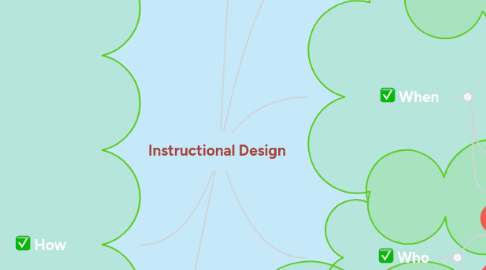
1. How
1.1. Technology Integration
1.1.1. Hard
1.1.1.1. Tools
1.1.2. Soft
1.1.2.1. Methods
1.1.2.2. Software/Website
1.2. ADDIE
1.2.1. Analysis
1.2.1.1. Design of course
1.2.1.2. Audience
1.2.1.3. Goal
1.2.1.4. Objectives
1.2.1.5. Identify content
1.2.1.6. Identify Environment and Delivery
1.2.1.7. Instructional Strategies
1.2.1.8. Assessment Strategies
1.2.1.9. Formative Evaluation
1.2.1.10. Constraints
1.2.2. Design
1.2.2.1. Name the learning units of Instruction
1.2.2.2. Identify content and strategies for an individual unit of instruction
1.2.2.3. Write instructions for the learning unit
1.2.2.4. Name the menu items for a learning module
1.2.3. Develop
1.2.3.1. Based on design phase
1.2.3.2. Upload content
1.2.3.3. Build content, assignments, assessment
1.2.3.4. Build course structure
1.2.4. Implement
1.2.4.1. Overview of course
1.2.4.2. Expectations
1.2.4.3. Initiate instruction
1.2.4.4. Interaction
1.2.4.5. Ask for feedback early on (formative evaluation)
1.2.5. Evaluation
1.2.5.1. Did the students achieve expected learning outcomes?
1.2.5.2. What have you learned?
1.2.5.3. How can you make the course better?
2. What: Definition
2.1. Models (Sets of Strategies)
2.1.1. Gagne
2.1.2. ADDIE
2.1.2.1. Analysis
2.1.2.1.1. Learning Environment Analysis
2.1.2.1.2. Learner Analysis
2.1.2.1.3. Instructional Content Analysis
2.1.2.2. Design
2.1.2.2.1. Strategies
2.1.2.3. Development
2.1.2.3.1. Strategies
2.1.2.4. Implementation
2.1.2.5. Evaluation
2.1.2.5.1. Formative Evaluation
2.1.2.5.2. Summative Evaluation
2.2. Definition
2.2.1. A systematic process, based on educational theories, on the development of instructional strategies, and specifications to promote quality learning experience.
2.2.2. Knowledge of how people learn, the available tools, how to apply those tools, and to engineer a plan to enhance the teaching and learning experience
3. Why
3.1. Quality
3.1.1. To ensure the quality of instructional media developed
3.2. Systematic
3.2.1. Systematic approach which provide ideas about planning, how people learn environment, media, products and system
4. Who
4.1. Designer
4.1.1. Educators
4.2. Beneficiary
4.2.1. Target Group (Learners)
4.2.2. Educators
5. Where
5.1. Lecture rooms
5.2. Studios
5.3. Learning spaces
5.4. Labs
5.5. Networked Computer
5.6. Mobile
5.7. Maker space
6. When
6.1. Pre-lesson
6.1.1. Analyze
6.1.2. Design
6.1.3. Develop
6.2. During lesson
6.2.1. Implement
6.3. Post-lesson
6.3.1. Evaluate
